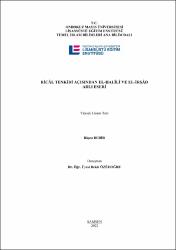Rical tenkidi açısından el-halili ve el-irşad adlı eseri
Citation
Bedir, B. (2022). Rical tenkidi açısından el-halili ve el-irşad adlı eseri. (Yüksek lisans tezi). Ondokuz Mayıs Üniversitesi, Samsun.Abstract
Hz. Peygamber’den sadır olan hadislerin korunması düşüncesi Müslüman
âlimleri isnad sistemini uygulamaya ve bu meyanda hadis râvi tercemelerinin
verildiği ve hadislerin sıhhatinin tespiti için senedde yer alan râvilerin cerh-ta’dîl
durumlarının belirlendiği eserler yazmaya sevk etmiştir. Hicri ilk asırlarda başlayan
bu süreç, özellikle de üçüncü asırda temel hadis kaynaklarının oluşturulması
neticesinde yüklü bir ricâl tenkidinin gerçekleştirilmesine sebep olmuştur. Ricâle dair
genel nitelikli biyografik eserler, râvilerin niteliklerine göre muhtevası şekillenen
çalışmalar, belirli bölge ve kitapların incelendiği eserler bu telif sürecinde ortaya
konulmuştur. Bu çalışmada H. V. asırda ricâl ilmi bünyesinde bölge esaslı eserlerden
el-İrşâd’ın müellifi Ebu Ya'la El-Halîlî’nin biyografisi özet bir şekilde sunularak
eserleri tanıtılmış, İrşâd isimli eserin muhteva ve kaynaklarına değinilerek ricâl ilmi
ve cerh-ta’dîl lafızları açısından tahlili yapılmıştır. Ayrıca İrşâd ile mütekkadîmmüteahhir dönemde kaleme alınan eserlerden İbn Adî’nin el-Kâmil fî dua’fâi’rRicâ’l
ve Zehebî’nin Mîzânü’l-i’tidâl’i yüz ortak râvi üzerinden incelenerek mukayese
edilmiştir. Böylelikle Hicri. IV. asrın V. asra, V. asrın H. VIII. asra intikalinde ricâl
ilmi ve cerh-ta’dîl lafızlarının gelişim serüveni ve yenilenmesi tespit edilmiştir.
Çalışmanın amacı, Halîlî’nin İrşâd’ı telif ve tasnif yöntemi, muhtevası,
kaynakları, râvi tanıtımında benimsediği metotların ve tenkid lafızlarının
belirlenmesidir. Böylece Halîlî’nin yaşadığı dönemin ricâl tenkidi içerisindeki
konumu ve cerh-ta’dîl lafızlarına dair kanaati değerlendirilmiş olacaktır.
Çalışma giriş ve üç bölümden oluşmaktadır. Girişte Hicri İlk Beş Asırda Ricâl
İlmi başlığı altında, isnad sisteminin uygulanmaya konulması, ricâle dair telif edilen
eserler ve bu süreçte ricâl ilminin doğuş ve gelişim seyri üzerinde durulmuştur.
Birinci bölümde Halîlî’nin hayatı ve eserleri, ikinci bölümde râvi biyografilerinin
nasıl ele alındığı, tenkid lafızları ve hadis ilmi açısından İrşâd değerlendirilmiştir.
Üçüncü bölümde ise İbn Adî ve Zehebî’nin eserleri İrşâd ile yüz ortak râvi üzerinden
incelenerek karşılaştırılmıştır.
Çalışmanın sonucunda, Halîlî’nin, ricâl biyografilerini sunmada ve cerh-ta’dîl
lafızlarında mütekaddim münekkidler ve yaşadığı dönemin üslûbunu yansıttığı
görülmüştür. Ancak bu ma’lum terceme ve elfazın yanı sıra onun “müttefekun aleyh,
şâz, illet” gibi kavramları cumhura muhalif şekilde kullandığı tespit edilmiştir. The idea of preserving the hadiths originating from the Prophet prompted
Muslim scholars to apply the isnad (attribution) system and to write works in which
the translations of hadith narrators are given and the cerh-ta'dil (evaluation of hadith
narrators) status of the narrators is determined for the sake of the authenticity of the
hadiths. This process, which started in the first centuries of the Hijri, led to the
realization of a heavy religious criticism, especially in the third century, as a result of
the creation of Basic Hadith sources. General biographical works on Rijal (Hadith
Narrators), studies whose content are shaped according to the characteristics of the
narrators, and works in which certain regions and books are examined have been
revealed in this copyright process. In this study, biography of Ebu Ya'la El-Halîlî, the
author of el-Irsad, one of the regional-based works of the Hijri V. century was
presented in a brief way and his works were introduced. The content and sources of
al-Irsad were analyzed in terms of rijâl science (science of narration) and cerh-ta’dîl
words. Further more, Ibn Adi's al-Kamil fî dua'fai'r-Ricâ'l and Zehebî’sMîzânü’li’tidâl, which are among the works written before and after al-Irshad, were examined
and compared over a hundred narrators. Thus, in the successing years of Hijri. IV. to
V. century and, H. V. to VIII. century, the developmental adventure and renewal of
rijâl science and cerh-ta’dîl words were determined.
Theaim of thestudy is todeterminethemethodsadopted in thepresentation of AlHalîlî's el-Irsad, itscontent, sources, andthecritiquewords. Thus, theposition of alHalîlî in theperiod of rijalcriticism in which he livedand his opinion on the cerhta’dîlwordswill be evaluated.
The study consists of an introduction and other three parts. In the introduction,
under the title of Rijal Science in the First Five Centuries of Hijri, the application of
the isnad system, the orks that were written about Rijal, and the birth and
development of Rijal in this process were emphasized. In the first part, al-Halîlî's life
and works, in the second part how the narrators’ biographies are analyzed an al-Irsad
in terms of criticism words and hadith science will be evaluated. In the third part, the
works of Ibn Adi and Zehebî are compared with al-Irsad based on over one hundred
narrators.
As a result of the study, it has been seen that al-Halîlî reflects the style of the
period he lived in presenting rijal biographies and in his cerh-ta’dîl words. However,
in addition to this well-known translation and words, it has been determined that he
used concepts such as "muttafekun aleyh (united on), şâz (contrariety), illet
(undetected at first)" in opposition to the people.
















